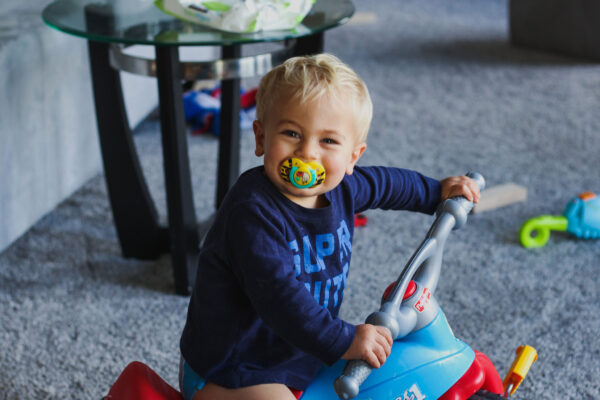What do we know about pacifiers and dental health? We know that babies have a strong sucking reflex, and some even suck their thumbs or fingers before they are born. We also know that pacifiers or soothers are used to calm down a baby. Ask any mom, and they will tell you that it’s a tried-and-true way to soothe a fussy baby. Make sure to have a pacifier handy to distract your little one when it’s time for a medical procedure. The next time your toddler joins you for a flight, make sure to have two ready-to-go. Your baby can’t intentionally pop their ears by swallowing, so sucking on a pacifier will relieve in-flight ear pain.
What is a Pacifier?
A pacifier is a device, typically made from rubber, plastic, or silicone, designed to mimic a nipple, offered to infants to suck on between feedings. This helps soothe them by fulfilling their natural sucking instinct when they’re not hungry. Pacifiers generally consist of three components: an elongated teat for sucking, a mouth shield to prevent over-insertion, and a handle for easy removal. Click here to book a dental appointment.
Should I Offer a Pacifier as the First Option?
Before resorting to a pacifier, try other soothing methods like rocking, changing positions, or burping your baby. If these don’t work, using a pacifier can be a comforting alternative, and it’s commonly used by many parents.
When is the Best Time to Introduce a Pacifier?
Concerns about pacifier use affecting breastfeeding might lead parents to wait until breastfeeding is well-established, usually around 3 to 4 weeks, before introducing a pacifier.
Pacifier and Dental Health
Prolonged or excessive use of pacifiers can affect oral development, potentially altering the roof of the mouth’s shape, hindering proper mouth growth, and leading to misaligned teeth.
How can I reduce dental harm?
It’s good to restrict pacifier use to when your child needs help falling asleep. A second very achievable goal is to wean your child off a pacifier at 12 months of age. If you need to use the pacifier more often and longer, then be proactive with jaw and teeth evaluations. The American Academy of Pediatrics advises that you have your child’s dentist evaluate her jaw and teeth if your child is still using his soother at three years of age. It’s best to get your child to stop sucking before permanent teeth come in, at about age five. Click here to book a dental appointment.
There are benefits to using a pacifier.
Benefits include being a temporary distraction at the doctor’s office, helping as a sleep aid, and increasing your chances of a successful flight.
According to WebMD. Pacifier usage during naps or nighttime might lower their risk of SIDS by more than half.
Cons:
- Pacifier use might increase the risk of middle ear infections.
- Pacifier use may interfere with speech development.
- Prolonged pacifier use might lead to dental problems
Smart Pacifier Use
Avoid forcing pacifier use on your baby; let your infant guide the decision-making. If your baby does not take to the pacifier, you can explore different sizes and shapes to determine the best fit. Keep the pacifier clean, and don’t clean the pacifier by putting it in your mouth. Inspect for wear and tear and tale away from the pacifier if your baby is chewing on it. A worn-out pacifier will break down, and the little pieces will break off and become a choking hazard.
Book A Dental Appointment

As with adults, your child needs to get their teeth cleaned and a dental checkup every six months. Kids should start going to the dentist soon after their first tooth erupts or around their first birthday, whichever happens first. Click here to book a dental appointment.
